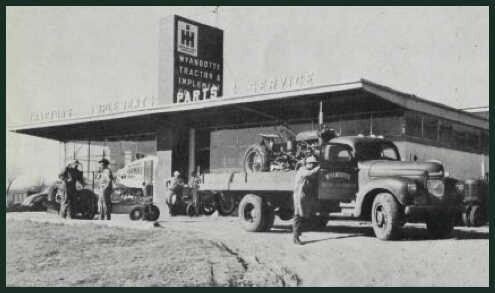The process was very similar to buying a car. Local farmer would go to the local dealership. Back in the era of my interest, the late 40s early 50s, just about every county in Iowa had multiple implement dealers, each selling their particular brand of tractors, etc. You mentioned IH, in the early 50s IH had a new design for local implement dealership building, a dark red brick building with glassed in show room, service bays, office, parts department, etc. just like an auto dealer. Many small town dealers were based in a garage like building. Some auto dealers also sold farm equipment, tractors, etc. For example a Ford auto dealer might also sell you a Ford tractor.

At the dealership, the farmer ordered what he wanted. Sometimes the conversation actually started at the county or state fair at a display booth or at a farm demonstration. Then just like a car, the waiting began. The dealer/salesman would notify the farmer once his purchased had arrived at the dealership. Typically delivered by rail on a flatcar or in a boxcar to the team track platform near the depot. Very few dealerships had direct rail service. The dealer would take possession at the teamtrack or local depot. The new equipment would be unloaded at the teamtrack ramp and then driven or transported to the dealership’s property, by the dealer’s employees. Tractors and combines could just be driven down the street. At the dealership it would be checked over for transit damage, and serviced for oil, grease, final assembly, etc. The farmer might be on hand to “supervise”. Then final delivery would take place. The dealer might deliver or the farmer’s son might even get the task of driving the new tractor home. Or the dealer might load it on a flatbed truck and deliver, if the farmer had a suitable ramp or earth berm for unloading.
As equipment got larger, dealerships moved to lowboy semi trailers, installed large hoists, A frames and even cranes. And the small dealers disappeared. Today few implement dealers exist in Iowa. And farmers often drive 50-100 miles or more to get parts or purchase a new tractor. Dealers in turn will pickup and deliver to the farm, and have field service trucks equipped to service a broke down tractor in the field.
Doug Harding
www.iowacentralrr.org
From: CBQ@groups.io <CBQ@groups.io> On Behalf Of Ashley Sarver
Sent: Thursday, September 3, 2020 5:08 PM
To: CBQ@groups.io
Subject: [CBQ] CB&Q and agricultural implements
Hi there,
This bulletin proved very helpful to a team member of mine a few years ago as we did research for the Middle Avenue/Alley Job Historic District in Aurora, IL. Please excuse my ignorance on this topic, as I am still learning more each time I do research on buildings on the important role of rail – however, I am no rail expert. I have another building I am working on getting listed on the National Register of Historic Places, the original International Harvester building at 6-12 N River St. in Aurora.
Now, I am seeking information about the role of the rail in the agricultural implements business. Does anyone have a resource, or can provide anecdotal insight into how it was that these large implements were sold; i.e. a farmer walks into a farm implement showroom (ala International Harvester) and decides to purchase a tractor. How was it that that tractor got to their farm? Or how was it that that farmer might have gotten that machinery repaired? The rail is obviously critical to their business model as almost all IH stores are located along a rail line. In Aurora, that’s the CB&Q. But I need to get more details on the purchasing/marketing/logistics of the purchase, sale, and delivery of equipment.
Thank you in advance!
Ashley

Ashley Sarver
Senior Urban Planner
O: 815-963-1900 | C: 815-315-3452 | www.studiogwa.com